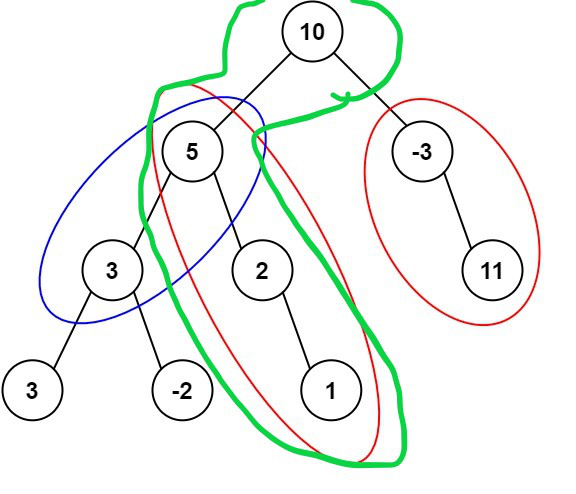var pathSum = function (root, targetSum) {
if (!root) return 0;
let paths = 0;
const nodeMap = new Map();
const DFS = (node, curSum) => {
if (curSum === targetSum) paths++;
if (nodeMap.has(curSum - targetSum)) paths += nodeMap.get(curSum - targetSum);
nodeMap.set(curSum, (nodeMap.get(curSum) || 0) + 1);
if (node.left) DFS(node.left, curSum + node.left.val);
if (node.right) DFS(node.right, curSum + node.right.val);
nodeMap.set(curSum, nodeMap.get(curSum) - 1);
};
DFS(root, root.val);
return paths;
};
這題可以使用 DFS + HashMap 來解題。首先用 DFS 搜尋二元樹的各個路徑,並同時將經過路徑的所有節點總和記錄在 HashMap。

例如當前走過了 10 => 5 => 2 => 1 的路徑(綠色線圈起的部分),hashMap 會有以下鍵值對
{ 10: 1, 15: 1, 17: 1, 18: 1}
此時拿 18 - 8(targetSum) = 10,10 存在於 HashMap 中,就可以知道在這條路徑下有一段路的節點總和為 targetSum,這種是從樹的中間層開始總和為 targetSum 的情況,而另一種 case 是從根節點的總和等於 targetSum 的情況,
有點像是以前遇過的 prefix sum 的概念
而為了避免會重複計算到路徑,當搜尋完回到二元樹的上層節點時,要記得把 hashMap 中的路徑減掉,例如搜尋完回到節點 2,減掉 key 為 18 的路徑一次,回到節點 5,減掉 key 為 17 的路徑一次。
case 範例: root = [1,-2,-3],targetSum = -1
時間複雜度: O(n)
空間複雜度: O(n)
Path Sum III | Leet code 437 | Theory explained + Python code
贾考博 LeetCode 437. Path Sum III
